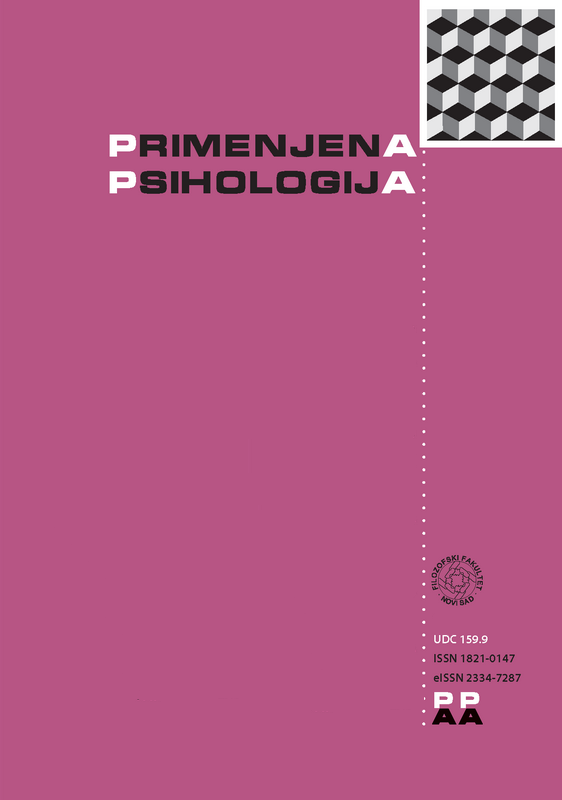EVALUATION OF A PROGRAM FOR PREVENTION OF EATING DISORDERS IN ADOLESCENTS
DOI:
https://doi.org/10.19090/pp.2016.3.243-260Keywords:
eating disorder prevention programs, evaluation, adolescentsAbstract
The aim of this study was to evaluate a prevention program for eating disorders (Dalle Grave & De Luca, 1999) in a female adolescent population in Serbia. This program aims to increase knowledge of eating disorders, as well as to reduce behaviors and habits associated with eating disorders. The study involved 84 female students from two high schools in Novi Sad, of which 57 students attended the program, and 37 were the control group. The average age of the students was 14.92 years, and the average body mass index (BMI) was 20.02. The prevention program lasted six weeks with sessions lasting 90 min. A set of self-assessment questionnaires was given to the experimental and control groups prior to implementation of the program, as well as 6 months after its implementation. The following instruments were applied: the Children's Eating Attitudes Test (ChEAT), the Self-Esteem Scale (SES), a questionnaire for assessing the implementation of the diet in adolescents (ADS), as well as a knowledge test about eating disorders, designed for the purpose of this research. The results indicate that six months after the implementation of the program the students in the experimental group showed a significantly higher level of knowledge than the students in the control group. The data analysis indicates a significant effect of the group, as well as the interaction between time and group in testing the level of knowledge. The authors conclude that the program for preventing eating disorders in schools is useful because it proved to be successful in increasing the level of knowledge about the risks of developing eating disorders.References
American Psychiatric Association. (2013). Diagnostic and statistical manual for mental disorders (5th ed.). Washington, DC: American Psychiatric Association.
Austin, S. B. (2000). Prevention research in eating disorders: Theory and new directions. Psychological Medicine, 30, 1249−1262. doi:10.1017/S0033291799002573
Bachman, J. G., O'Malley, P. M., Freedman-Doan, P., Trzesniewski, K. H., & Donnellan, M. B. (2011). Adolescent self-esteem: Differences by race/ethnicity, gender, and age. Self and Identity, 10, 445−473. doi:10.1080/15298861003794538
Carter, J. C., Stewart, D. A., Dunn, V. J., & Fairburn, C. G. (1997). Primary prevention of eating disorders: Might it do more harm than good? International Journal of Eating Disorders, 22, 167−172. doi:10.1002/(SICI)1098-108X(199709)22:2<167 ::AID-EAT8> 3.0.CO;2-D
Chubb, N. H., Fertman, C. I., & Ross, J. L. (1997). Adolescent self-esteem and locus of control: A logitudinal study of gender and age differences. Adolescence, 32, 113−132.
Cohen, J. W. (1988). Statistical power analysis for the behavioral sciences. Hisdale, New York: Lawrence Erlbaum Associates. doi:10.1002/bs.3830330104
Dalle Grave, R. D., Luca, L. D., & Campello, G. (2001). Middle school primary prevention program for eating disorders: A controlled study with a twelve-month follow-up. Eating Disorders, 9, 327−337. doi:10.1080/106402601753454895
Dalle Grave, R., & De Luca, L. (1999). Prevenzione dei disturbi dell’alimentazione. Un programma di educazione e prevenzione primaria e secondaria per operatori socio-sanitari. Verona: Positive Press.
Đurović, D. (2011). Psihološki činioci razlika između podtipova poremećaja ishrane (Neobjavljena doktorska disertacija). Filozofski fakultet, Univerzitet u Novom Sadu.
Fairburn, C. G., & Beglin, S. J. (1994). Assessment of eating disorders: Interview or self-report questionnaire? International Journal of Eating Disorders, 16, 363−370.
Fairburn, C. G., Cooper, Z., Doll, H. A., & Welch, S. L. (1999). Risk factors for anorexia nervosa: Three integrated case-control comparisons. Archives of General Psychiatry, 56, 468−476. doi:10.1001/archpsyc.56.5.468
Fairburn, C. G., Peveler, R. C., Jones, R., Hope, R. A., & Doll, H. A. (1993). Predictors of 12-month outcome in bulimia nervosa and the influence of attitudes to shape and weight. Journal of Consulting and Clinical Psychology, 61, 696−718. doi:10.1037/ 0022-006X.61.4.696
Fingeret, M., Warren, C. S., Cepeda-Benito, A., & Gleaves, D. H. (2006). Eating disorder prevention research: A meta-analysis. Eating Disorders, 14, 191−213. doi:10.1080 /10640260600638899
Finney, S. J., & DiStefano, C. (2006). Non-normal and categorical data in structural equation modeling. In G. R. Hancock & R. O. Mueller (Eds.), Structural equation modeling: A second course (pp. 269–314). Greenwich, CT: Information Age.
Garcia de Amusquibar, A. M., & De Simone, C. J. (2003). Some features of mothers of patients with eating disorders. Eating and Weight Disorders, 8, 225−230. doi:10.1007/ BF03325018
Halvarsson, K., Lunner, K., & Sjöden, P. O. (2000). Assessment of eating behaviours and attitudes to eating, dieting and body image in pre‐adolescent Swedish girls: A one‐year follow‐up. Acta Paediatrica, 89, 996−1000. doi:10.1111/j.1651-2227. 2000.tb00424.x
Heatherton, T. F., & Polivy, J. (1991). Development and validation of a scale for measuring state self-esteem. Journal of Personality and Social Psychology, 60, 895−906. doi:10.1037/0022-3514.60.6.895
Hoek, H. W. (2006). Incidence, prevalence and mortality of anorexia nervosa and other eating disorders. Current opinion in psychiatry, 19, 389−394. doi:10.1097/01.yco. 0000228759. 95237.78
Janis, I. L., & Field, P. B. (1959). Sex differences and factors related to persuasibility. In C. I. Hovland & I. L. Janis (Eds.), Personality and persuasibility. New Haven, CT: Yale University Press.
Kater, K. J., Rohwer, J., & Londre, K. (2002). Evaluation of an upper elementary school program to prevent body image, eating, and weight concerns. Journal of School Health, 72, 199−204. doi:10.1111/j.1746-1561.2002.tb06546.x
Kontić, O., Vasiljević, N., Trišović, M., Jorga, J., Lakić, A. i Jašović, G. M. (2012). Poremećaji ishrane. Srpski arhiv za celokupno lekarstvo, 140, 673−678.
Lazarević, J., Batinić, B., & Vukosavljević-Gvozden, T. (2015). Risk factors and the prevalence of anorexia nervosa among female students in Serbia. Vojnosanitetski pregled, 73, 34−41.
Levine, M. P., & Smolak, L. (2001). Primary prevention of body image disturbances and disordered eating in childhood and early adolescence. In J. K. Thompson & L. Smolak (Eds.), Body image, eating disorders, and obesity in youth: Assessment, prevention, and treatment (pp. 237−260). Washington, DC: American Psychological Assosacition. doi:10.1037/10404-010
Maloney, M. J., McGuire, J. B., & Daniels, S. R. (1988). Reliability testing of a children's version of the Eating Attitude Test. Journal of the American Academy of Child & Adolescent Psychiatry, 27, 541−543. doi:10.1097/00004583-198809000-00004
Mann, T., Nolen-Hoeksema, S., Huang, K., Burgard, D., Wright, A., & Hanson, K. (1997). Are two interventions worse than none? Joint primary and secondary prevention of eating disorders in college females. Health Psychology, 16, 215−223. doi:10.1037/0278-6133.16.3.215
Matusek, J. A., Wendt, S. J., & Wiseman, C. V. (2004). Dissonance thin‐ideal and didactic healthy behavior eating disorder prevention programs: Results from a controlled trial. International Journal of Eating Disorders, 36, 376−388. doi:10.1002/eat. 20059
Neumark-Sztainer, D. (2009). Preventing obesity and eating disorders in adolescents: What can health care providers do? Journal of Adolescent Health, 44, 206−213. doi:10.1016/j.jadohealth.2008.11.005
Nobakht, M., & Dezhkam, M. (2000). An epidemiological study of eating disorders in Iran. International Journal of Eating Disorders, 28, 265−271. doi:10.1002/1098-108X(200011)28:3<265::AID-EAT3>3.0.CO;2-L
O’Brien, K. M., & LeBow, M. D. (2007). Reducing maladaptive weight management practices: Developing a psycho educational intervention program. Eating Behaviors, 8, 195−210. doi:10.1016/j.eatbeh.2006.06.001
Patton, G. C, Carlin, J. B., Shao, Q., Hibbert, M. E., Rosier, M., Selzer, R., & Bowes, G. (1997). Adolescent dieting: Healthy weight control or borderline eating disorder? Journal of Child Psychology and Psychiatry, 38, 299−306. doi:10.1111/j.1469-7610.1997.tb01514.x
Pokrajac-Bulian, A., Mohorić, T. i Đurović, D. (2007). Odstupajuće navike hranjenja, nezadovoljstvo tijelom i učestalost provođenja dijete kod hrvatskih srednjoškolaca. Psihologijske teme, 16, 27−46.
Pokrajac-Bulian,A., Živčić-Bećirević, I., Calugi, S., & Dalle Grave, R. (2006). School prevention program for eating disorders in Croatia: A controlled study with six months of follow-up. Eating Weight Disorders, 11, 1−8. doi:10.1007/BF03327568
Preti, A., de Girolamo, G., Vilagut, G., Alonso, J., de Graaf, R., Bruffaerts, R., … ESEMeD-WMH Investigators (2009). The epidemiology of eating disorders in six European countries: Results of the ESEMeD-WMH project. Journal of Psychiatric Research, 43, 1125−1132. doi:10.1016/ j.jpsychires.2009.04.003
Renfrew Center Foundation. (2002). Eating disorders: A summary of issues, statistics and resources. Retrieved from http://www.renfrew.org
Rodríguez-Cano, T., Beato-Fernández, L., & Belmonte-Llario, A. (2005). New contributions to the prevalence of eating disorders in Spanish adolescents: Detection of false negatives. European Psychiatry, 20, 173–178. doi:10.1016/ j.eurpsy.2004.04.002
Roehrig, M., Thompson, J. K., Brannick, M., & Van den Berg, P. (2006). Dissonance‐based eating disorder prevention program: A preliminary dismantling investigation. International Journal of Eating Disorders, 39, 1−10. doi:10.1002/eat.20217
Ross, C. E., & Broh, B. A. (2000). The roles of self-esteem and the sense of personal control in the academic achievement process. Sociology of Education, 23, 270−284. doi:10.2307/2673234
Shaw, H., Stice, E., & Becker, C. B. (2009). Preventing eating disorders. Child and Adolescent Psychiatric Clinics of North America, 18, 199−207. doi:10.1016/ j.chc.2008 .07.012
Shisslak, C. M., Crago, M., Neal, M. E., & Swain, B. (1987). Primary prevention of eating disorders. Journal of Consulting and Clinical Psychology, 55, 660−667. doi:10.1037 /0022-006X.55.5.660
Stice, E., Marti, C. N., Spoor, S., Presnell, K., & Shaw, H. (2008). Dissonance and healthy weight eating disorder prevention programs: Long-term effects from a randomized efficacy trial. Journal of Consulting and Clinical Psychology, 76, 329−338. doi: 10.1037/0022-006X.76.2.329
Stice, E., Orjada, K., & Tristan, J. (2006) Trial of psychoeducational eating disturbance intervention for college women: A replication and extension. International Journal of Eating Disorders, 39, 233–239. doi: 10.1002/eat.20252
Stice, E., Shaw, H., & Marti, C. N. (2007). A meta-analytic review of eating disorder prevention programs: Encouraging findings. Annual Review of Clinical Psychology, 3, 207−231. doi: 10.1146/annurev.clinpsy.3.022806.091447
Stice, E., Trost, A., & Chase, A. (2003). Healthy weight control and dissonance-based eating disorder prevention programs: Results from a controlled trial. International Journal of Eating Disorders, 33, 10−21. doi: 10.1002/eat.10109
Sullivan, P. F. (1995). Mortality in anorexia nervosa. American Journal of Psychiatry, 152, 1073−1074. doi: 10.1176/ajp.152.7.1073
Szmukler, G. I., & Patton, G. (1995). Sociokultural models of eating disorders. In G. Szmukler, C. Dare, & J. Treasure (Eds.), Handbook of eating disorders: Theory, treatment and research (pp. 197−220). New York: John Wiley & Sons.
Treasure, J., Schmidt, U., & van Furth, E. (Eds.) (2003). Handbook of eating disorders. Chichester: John Wiley & Sons. doi: 10.1002/0470013443
Tremblay, M. S., Inman, J. W., & Willms, J. D. (2000). The relationship between physical activity, self-esteem, and academic achievement in 12-year-old children. Pediatric Exercise Science, 12, 312−323.
Wigfield, A., & Eccles, J. S. (2000). Expectancy-value theory of achievement motivation. Contemporary educational psychology, 25, 68−81. doi:10.1006/ceps. 1999. 1015







